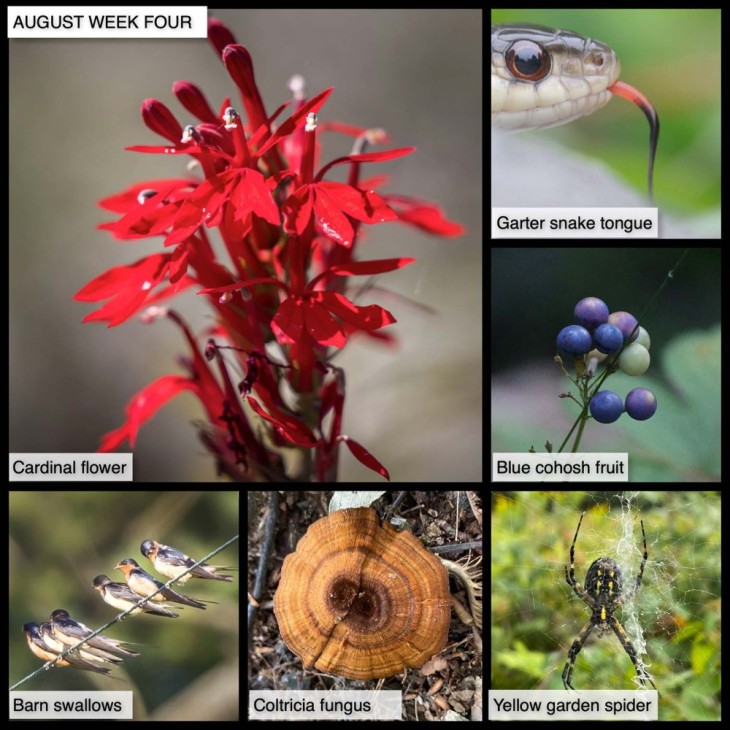This Week in the Woods, we found patches of cardinal flower blooming along the Connecticut River. As noted in this profile from The Native Plant Trust, these vivid summer wildflowers – which often grow at the water’s edge – are part of the Lobelia genus and are often pollinated by hummingbirds.
Here are some other nature sights this week (clockwise):
We found this garter snake sunbathing on a stone wall and were able to get a close look at its behavior of flicking its tongue to monitor scents. Check out this fun Outside Story essay by Laurie Morrissey, who describes the behavior as “scooping the air toward your nose when someone takes a pie out of the oven.” As she explains, snakes’ forked tongues enable them to sample air molecules from two different points, and therefore determine scent direction. Fast tongue flicking increases the amount of information that the snake receives.
This is a good time to find ripening berries in the woods, although it’s important to keep in mind that even tasty-looking ones, such as beautiful clusters of blue cohosh berries, can be highly toxic. As noted in this profile from the Lady Bird Johnson Wildflower Center, the developing seeds will eventually rupture out of the fruit, and (supposedly) can be used as a coffee substitute, “but may also be toxic.” Which begs some interesting questions about how and why someone figured this out.
Assistant editor Meghan McCarthy McPhaul took this great image of a yellow garden spider (which also goes by a number of other names, including zigzag spider and black and yellow argiope). These spiders are becoming more noticeable as they get bigger and often construct their webs higher above the ground. As Rachel Sargent Mirus notes in this Outside Story essay, the zigzag formation on this species’ web is an example of a stabilimentum – a structure made of a different kind of silk than is used for other parts of the web, and which is much more conspicuous. A number of orb-web spiders create stabilimenta, but why they do this is up for debate. Mirus describes two leading explanations: that insect prey are attracted to stabilimenta, which reflect ultraviolet light and to insect eyes, may resemble flowers; or that the stabilimenta serve as camouflage, confusing wasps and other predators that seek out the distinctive shape of a spider perched on its web.
McPhaul also found some specimens of Coltricia fungus. We’ve typically found these banded fungi growing in small clusters along trails, straight out of soil or in moss. Here’s a profile of Coltricia cinnamomea, also known as shiny cinnamon polypore, from The Mushroom Expert blog.
Finally, Tig Tillinghast shared this image of barn swallows perched along a wire. Like other swallows, the birds often catch prey on the wing. It’s fun to watch their aerial acrobatics, as well as their skimming flights to scoop water into their bills. As noted in this profile from the Cornell Lab’s All About Birds site, barn swallows have (along with many other birds) experienced a population decline, although they have an advantage over many species in that they’re well adapted to using human-made structures and habitats. The birds in this photo, for example, have been successfully nesting under a highway bridge.
Our thanks to The Bailey Charitable Foundation and the Frank and Brinna Sands Foundation for helping to support this series.
In this difficult period, many of us find joy in observing local nature. This series, launched in April 2020, shares nature photographs taken in the past seven days, or in the same week in 2020, most within 15 miles of the Northern Woodlands office in Lyme, New Hampshire. We hope you enjoy using this grid as a prompt for your own explorations.
What are you seeing in the woods this week? Share your images with us on Facebook, or submit a special photo for possible inclusion in our monthly online Reader Photo Gallery.


